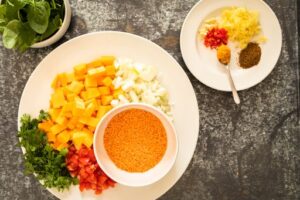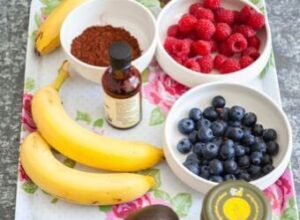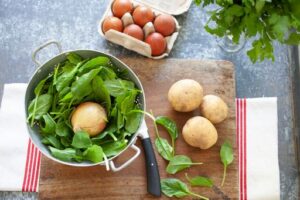Spring Clean your Store Cupboard!
Dr Joan Ransley tells us about her eight store cupboard staple ingredients that are also good for your gut health as Love Your Gut takes a look at how to Spring Clean Your Store Cupboard!

Foods such as bananas, beans, berries, nuts and vegetables offer fibre, which many of us don’t get enough of1 and which can help support digestion and prevent constipation,2 as well as prebiotics and other important nutrients. In addition, to offering a number of digestive health benefits, these foods also taste great and can be enjoyed in a host of different ways from breakfast to supper.
Pulses (such as beans, lentils and chickpeas)
A pulse is an edible seed that grows in a pod. Pulses like beans, lentils and chickpeas contain both dietary fibre and prebiotics known as galacto-oligosaccharides which travel through the gut and reach the colon. Here, they are fermented by healthy gut bacteria producing important molecules to keep the immune system functioning efficiently and the cells lining the gut healthy and free from disease.3
In addition, pulses contain soluble fibre, which supports bowel health. Studies have shown improvements in bowel health in people including chickpeas in their diet, including reporting going to the toilet more often and more easily, and softer stool consistency.4
Bananas
Bananas contain dietary fibre and a prebiotic called fructo-oligosaccharide or FOS for short. FOS cannot be digested in the upper part of the digestive tract so travels through the gut to be fermented in the colon, allowing healthy bacteria to thrive.5 Dietary fibre has two important roles; it bulks the stool which can deliver nutrients to the most distal part of the gut and brings undigested food that can be fermented by bacteria in the colon thereby aiding gut health.6
As bananas ripen their carbohydrate composition changes and unripe bananas contain resistant starch, a form of carbohydrate resistant to digestion. When this starch reaches the colon it is fermented by gut bacteria and this in turn produces many bioactive substances, beneficial for gut health.

Green Vegetables (such as spinach and kale)
Green vegetables, such as spinach and kale, are a rich source of a group of chemicals called polyphenols. Polyphenols can act as antioxidants in the body – helping neutralise harmful free radicals that can cause disease. When polyphenols reach the bacteria in the gut they are broken down into smaller by-products and used as fuel to produce chemicals that send messages to the immune system.
Kale contains substances called glucosinolates, which are broken down by chewing to form isothiocyanates. These react with the cell walls of the colon and may help to reduce risk of cancer cells developing.7

Berries
Berries are rich in polyphenol compounds such as flavonoids like anthocyanins. In the colon, polyphenols are metabolised by micro-organisms/gut bacteria into smaller phenolic compounds, which can enter the circulation and reach the organs in the body. Polyphenols and their metabolites can modulate the microbial populations, leading to an increase in healthy bacteria such as Bifidobacteria and Lactobacilli. Berries have also been shown to alleviate symptoms of gut inflammation and may help to reduce risk of cancer in the colon.8
Nuts
Eating nuts, in moderate quantities, is associated with a number of beneficial health outcomes, such as helping to reduce heart disease and type 2 diabetes risk, which have been mainly attributed to their fatty acid profile. Nuts also contain prebiotic components including dietary fibre and other complex polysaccharides, which provide substrates for the gut bacteria to ferment and form new bioactive substances associated with the health benefits of eating nuts. Consuming nuts, such as almonds, regularly over the course of several weeks has been shown to increase populations of healthy bacteria in the large intestine.9

Cocoa powder
Cocoa is one if the richest sources of polyphenols in food. Besides stimulating beneficial bacteria growth, laboratory studies have also shown that cocoa powder may help to inhibit the growth of pathogens such as Escherichia coli, Salmonella, and Listeria. However, this is yet to be demonstrated in humans.10
Virgin olive oil
Several studies have shown extra virgin olive oil to be good for gut health. This is because virgin olive oil contains polyphenols, which are well known for their antimicrobial activity on certain bacteria, as well as for their anti-inflammatory and antioxidant effects.11 Virgin olive oil contains more polyphenols than refined olive oil,12 so is a great choice for salad dressings and dishes where the quality of the oil will shine through.
Colourful vegetables
Colourful vegetables such as tomatoes and peppers contain a range of phytochemicals (literally “plant chemicals”) that give them not only their colour but also their taste. Such vegetables contain both polyphenols and dietary fibre which can promote healthy populations of gut bacteria. In healthy subjects, this combination of dietary fibre and polyphenols generally lead to an increase in healthy bacteria such as Bifidobacteria and Lactobacilli.13
Armed with Dr Joan’s advice maybe it’s time to Spring Clean your Store Cupboard!
For more information visit: www.loveyourgut.com
References:
[1] https://www.nhs.uk/live-well/eat-well/good-foods-to-help-your-digestion/
2https://www.nhs.uk/live-well/eat-well/how-to-get-more-fibre-into-your-diet/
3 Wilson B & Whelan K. (2017) Prebiotic inulin‐type fructans and galacto‐oligosaccharides: definition, specificity, function, and application in gastrointestinal disorders. J Gastroenterol Hepatol. 32 Suppl 1:64-68 https://doi.org/10.1111/jgh.13700
4 Murty CM, Pittaway JK & Ball MJ. (2010) Chickpea supplementation in an Australian diet affects food choice, satiety and bowel health. Appetite 54: 282–288. DOI: 10.1016/j.appet.2009.11.012
5 Tandon et al. (2019) A Prospective Randomized, Double-Blind, Placebo-Controlled, Dose-Response Relationship Study to Investigate Efficacy of Fructo-Oligosaccharides (FOS) on Human Gut Microflora. Sci Rep 9(1):5473. doi: 10.1038/s41598-019-41837-3.
7 Soundararajan P & Kim JS. (2018) Anti-Carcinogenic Glucosinolates in Cruciferous Vegetables and Their Antagonistic Effects on Prevention of Cancers. Molecules. 23(11):2983. doi:10.3390/molecules23112983
8 Lavefve L, Howard LR & Carbonera F. (2020) Berry polyphenols metabolism and impact on human gut microbiota and health. Food Function. 11:45-65 https://doi.org/10.1039/C9FO01634A
9 Lamuel-Raventos RM & Onge MS (2017). Prebiotic nut compounds and human microbiota. Crit Rev Food Sci Nutr. 57(14):3154‐3163. doi:10.1080/10408398.2015.1096763
10 Calatayud M et al. (2013) Active films based on cocoa extract with antioxidant, antimicrobial and biological applications. Food Chem. 139(1-4):51‐58. doi:10.1016/j.foodchem.2013.01.097
11 Gavahian M, Khaneghah AM, Lorenzo JM et al. (2019) Health benefits of olive oil and its components: Impacts on gut microbiota antioxidant activities, and prevention of noncommunicable diseases, Trends in Food Science & Technology. 88:220-227 https://doi.org/10.1016/j.tifs.2019.03.008
12 Gorzynik-Debicka M, Przychodzen P, Cappello F et al. (2018) Potential Health Benefits of Olive Oil and Plant Polyphenols. Int J Mol Sci. 19(3):686. doi:10.3390/ijms19030686
13 Tim Spector. The Diet Myth. P82. Weidenfeld & Nicholson

